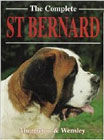
The Complete St Bernard (Book of the Breed)
St Bernards are famous as rescue dogs. They are generally gentle, friendly, and very patient and tolerant with children. They are very similar to Newfoundlands, and, like Newfoundlands, need to be taught house rules while they are pups, including no rough games indoors. They are such big dogs, that they can easily knock over small people, not to mention treasured ornaments. Like Newfoundlands, they are droolers, withstand cold well, and shed a lot in spring time.
St Bernards can also be quite barky, and their barks are loud and deep. This means that they can be good watchdogs, though they are too friendly to be guard dogs. There are two types, longer and shorter haired St Bernards, and neither needs a lot of grooming, though regular brushing helps them to look good and cuts down on shedding. These dogs need especial care with their diet and exercise while they are growing, to avoid problems with bone development. Other common health problems include heart trouble, hip dysplasia, and entropion. They can also suffer when it's hot, so should only be walked in the early morning or after dark, during periods of hot weather. St Bernards don't need a lot of exercise, though they do benefit from regular walks, preferably at least one a day to keep fit.
They are, sadly, not a long lived breed, even for a giant breed, and heart problems are all too common. Anyone interested in a St Bernard pup should do a lot of research on the longevity of the pup's ancestors, and ask themselves whether they could cope with losing their dog after a relatively short time. This guide gives an excellent overview of the breed, with good advice on general care, as well as an informative account of the history of the breed as a rescuing dog, and its rise in popularity as a companion dog.



